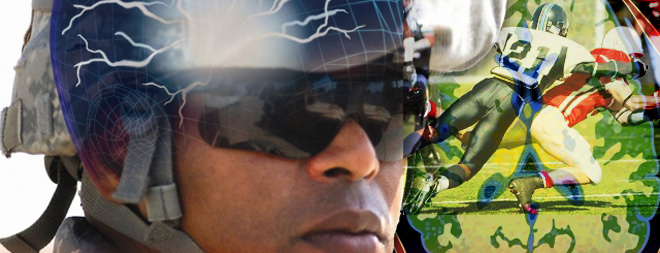Football, Explosions Rattle Brain in Similar Ways

Composited by Inside Science
(ISNS) -- Scientists studying brain injuries are bringing together findings from two different settings -- the football field and the battlefield -- to develop new ways to protect football players, and to identify new insights into preventing what was once known to soldiers as "shell shock."
A disorder that damages an athlete's brain function results from the same kinds of concussions affecting soldiers caught in explosive blasts from such weapons as improvised explosive devices in Iraq and Afghanistan.
The issue has become urgent to the NFL because of a class action lawsuit filed by former players claiming the league and the manufacturer of their helmets didn't warn them of the dangers of head trauma.
Several prominent former players now suffer from obvious brain damage. Surveys show that parents are growing reluctant to let their children play tackle football because of the dangers, which could endanger the future of the sport.
Retired NFL players died with damaged brains at a much higher rate than the general population, according to a new study, but scientists have found that the amount of damage their brains received depended on what position they played.
Research published May 16 in the journal Neurology by scientists at the National Institute for Occupational Safety and Health in Cincinnati found that defensive and offensive linemen did not show notable brain damage while those in "speed" positions -- quarterbacks, running backs, wide receivers, tight ends, safeties, and linebackers, did.
Epidemiologist Everett J. Lehman, the lead author, in the study said the difference was that while those in more stationary positions repeatedly came in violent contact with other players, they were not going as fast as players who had time to work up velocity and momentum. Lehman said the impacts and the concussions, therefore, were less serious for players in non-speed positions.
The study involved 3,439 former NFL players who played at least five years from 1959-88, and looked at the cause of death.
The researchers looked specifically at Alzheimer's disease, ALS (also known as Lou Gehrig's disease), and Parkinson's disease -- all of which involve damaged brain cells. They found no relationship with Parkinson's, but the former speed position players died of a disease that resembled Alzheimer's and ALS at three times the rate of the general population.
The results are somewhat fuzzy because the study used death certificates, which can list something else -- pneumonia, for instance -- as a cause of death of a person who died with Alzheimer's.
Further, physicians now recognize a syndrome called chronic traumatic encephalopathy, or CTE, a general description of brain damage caused by traumatic shock that can produce symptoms that look like Alzheimer's or ALS but are not. The only way to determine if the player died of CTE or one of the other conditions would be with an autopsy.
"They would not have CTE listed as a cause of death," Lehman said. "The physics of it is, either the head is in motion and hits a fixed surface, or the head is in a fixed position and something hits it."
Either way, the brain bangs into the skull.
In the case of soldiers struck by the explosion of an IED, what happens to the head is the same if the cause is different.
Researchers at Boston University School of Medicine and Veteran Affairs Boston Healthcare System, took the brains of four veterans, four young athletes, and young men who were neither, and found what happened to the veteran's brains was exactly what happened to the athletes. The athletes in the study were not professional football players, but were known to have suffered repeated head blows from either football or wrestling.
In both cases, they found the tangles from a protein called tau always present in Alzheimer's patients, but did not find the amyloid plaque of Alzheimer's. The brains of the eight "were pathologically indistinguishable from each other," wrote the Boston University researchers in Science Translational Medicine.
In the soldiers, the trauma was caused by the explosion of the IED, not by a linebacker, but the researchers found that while the effect was the same, the cause was entirely different from what was expected, according to Lee Goldstein, the lead author of the article.
The assumption, Goldstein said, was that the supersonic blast wave from the explosion did the damage but it turns out the real damage was done by the wind that followed the wave. The shock wave transferred very little energy to the head.
Roaring away from the explosion at speeds of more than 330 mph, the wind rattled the soldier's head in what Goldstein called the "bobble head effect," shaking the brain against the skull.
"It is the rotational and angular acceleration resulting from the impact that does the damage," Goldstein said.
According to Goldstein, no one could understand how one blast could do that.
"It turned out not to be one insult but multiple insults very short periods of time," Goldstein said. "The head bobbles back and forth very high acceleration over milliseconds."
Additionally, using a blast of compressed air, the Boston researchers simulated of the effects of an explosion on mice. Two weeks later, after only one blast, the mice showed problems with learning and memory that lasted for at least a month.
Further tests showed that keeping the mice's head immobilized eliminated the bobble head effect and no damage was seen. Immobilized mice showed no signs of the blast.
While helmets that immobilize the head are not considered likely for either soldiers or football players, Goldstein said the Department of Defense is interested in the studies, hoping to find a way to protect its personnel from the blasts.

